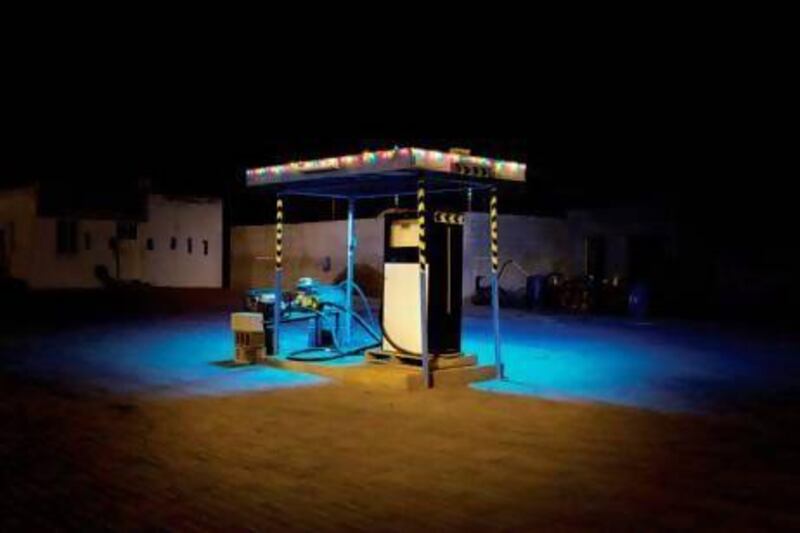The ramshackle corrugated iron roof appears only to balance on its rusted stand and the neon sign, glowing beacon-yellow above it, makes the seemingly precarious structure look as if it is about to fall. If the tiny hut, housing a diesel pump, looks neglected that is because it is an endangered element of urban life, under threat from the perpetual desire for newness.
This is Substation 1-1 in Al Ghail, a small village in Ras Al Khaimah and the image is one of Sinisa Vlajkovic and Mohamed Somji's photographic series documenting independently owned diesel stations, unique to the emirates of Ajman and Ras Al Khaimah.
Photographed at night, the neon signs pierce the blackened skies and give them a kind of eerie ambience, making you wonder if they are real or imagined. Perhaps that is the whole point - these humble buildings will soon, most likely, be crushed by the dominating march of urbanisation stomping its way across the UAE's ever changing landscape. Substations was chosen as part of three exhibitions to embody the theme of the latest group show at Dubai's Cuadro Gallery. Here Today - A Record Of Urban Impermanence opened this week at the Dubai International Financial Centre space with the aim of documenting and imagining the impact of disappearance on our cities.
On the road
Adjacent to the photographic series is Vikram Divecha's Urban Epidermis - huge hulking pieces weighing more than 100 kilograms each and created to resemble exactly, in material and technique, pieces of road. The young Indian artist, who was born in Lebanon and is now based in Dubai, spent time in an asphalt mixing plant to acquire the tar and then applied layer upon layer to create the slabs. He then applied paint and created cracks and stains - to symbolise wear and tear.
If his road were real it would soon be tarred with a new layer, thus removing the memory and the imprint of the countless journeys made upon it. Much like the diesel stations, these records of the past are presented as impermanent and fragile. Alaa Al Shroogi, the gallery director, says: "We're seeing more and more work focused on documenting and imagining the fleeting and the transient. This is especially prevalent in areas witnessing rapid industrialisation."
Where the past and the future converge
The final series in the show is Sami Al Turki's Washaeg (Nexus). Here the Saudi photographer revisits Obhur's Red Sea coastline in Jeddah, where he spent much of his childhood. His images capture dramatic sky-scapes with dilapidated urban structures in the foreground. The infrastructure represents life that has long since disappeared and the overall effect is a kind of post-apocalyptic dream. Al-Turki manipulates his photographs to transport the viewer and draw them into his world. You leave the show wanting to go back for a second look.
[ aseaman@ thenational.ae ]
Here Today - A Record of Urban Impermanence is at Cuadro Gallery, Building 10, DIFC Gate Village until March 14. Visit www.cuadroart.com for details
Follow us
[ @LifeNationalUAE ]





